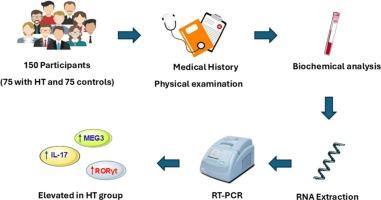连接lncRNA MEG3, RORγt和IL-17与桥本甲状腺炎免疫失调:早期诊断和监测的潜力
IF 0.9
Q4 GENETICS & HEREDITY
引用次数: 0
摘要
本研究的重点是桥本甲状腺炎(HT),一种慢性自身免疫性甲状腺疾病,可引起甲状腺炎症和免疫介导的损伤。研究生物标志物可以改善HT的诊断和治疗。本研究旨在探讨lncRNA MEG3、RORγt和IL-17基因表达之间的相关性,以及它们作为HT患者诊断和预测指标的可能用途。方法150名参与者平均分为HT患者和健康人。进行了各种评估,包括病史、体格检查和实验室检查。从采集的血样中提取RNA后,采用实时荧光定量PCR方法定量lncRNA MEG3、RORγt和IL-17的转录水平。结果HT患者的lncRNA MEG3、rorγ - t和IL-17基因表达水平高于对照组。研究发现lncRNA MEG3 &;r γt, r γt &;IL-17以及lncRNA MEG3 &;IL-17。结论lncrna MEG3和IL-17是HT的预测因子。这些标志物水平的升高与病情的严重程度有关。LncRNA MEG3参与调控基因表达和免疫活性,IL-17作为促炎细胞因子。它们显示出作为诊断和监测的生物标志物的潜力,但需要更大规模、长期的蛋白质水平验证研究来证实它们的临床价值。本文章由计算机程序翻译,如有差异,请以英文原文为准。

Linking lncRNA MEG3, RORγt, and IL-17 to immune dysregulation in Hashimoto's thyroiditis: Potential for early diagnosis and monitoring
Background
The study focused on Hashimoto's thyroiditis (HT), a chronic autoimmune thyroid disorder that causes inflammation and immune-mediated damage to the thyroid gland. Investigating biomarkers could improve the diagnosis and treatment of HT. This research was conducted to explore the correlation among lncRNA MEG3, RORγt, and IL-17 gene expressions and their possible utility as diagnostic and predictive markers in HT patients.
Methods
The research involved 150 participants split evenly between HT patients and healthy individuals. Various assessments were performed, including histories, physical exams, and lab tests. The transcript levels of lncRNA MEG3, RORγt, and IL-17 were quantified using real-time PCR following RNA extraction from collected blood samples.
Results
Higher levels of lncRNA MEG3, RORγt, and IL-17 gene expressions were indicated in HT patients in comparison with those in the control group. The study found significant positive correlations between lncRNA MEG3 & RORγt, RORγt & IL-17, as well as lncRNA MEG3 & IL-17.
Conclusion
LncRNA MEG3 and IL-17 were identified as predictors of HT. Elevated the levels of these markers were related to the severity of the condition. LncRNA MEG3 contributes to the control of gene expression and immune activities, while IL-17 acts as a proinflammatory cytokine. They show potential as biomarkers for diagnosis and monitoring, but larger, long-term studies with protein-level validation are needed to confirm their clinical value.
求助全文
通过发布文献求助,成功后即可免费获取论文全文。
去求助
来源期刊

Gene Reports
Biochemistry, Genetics and Molecular Biology-Genetics
CiteScore
3.30
自引率
7.70%
发文量
246
审稿时长
49 days
期刊介绍:
Gene Reports publishes papers that focus on the regulation, expression, function and evolution of genes in all biological contexts, including all prokaryotic and eukaryotic organisms, as well as viruses. Gene Reports strives to be a very diverse journal and topics in all fields will be considered for publication. Although not limited to the following, some general topics include: DNA Organization, Replication & Evolution -Focus on genomic DNA (chromosomal organization, comparative genomics, DNA replication, DNA repair, mobile DNA, mitochondrial DNA, chloroplast DNA). Expression & Function - Focus on functional RNAs (microRNAs, tRNAs, rRNAs, mRNA splicing, alternative polyadenylation) Regulation - Focus on processes that mediate gene-read out (epigenetics, chromatin, histone code, transcription, translation, protein degradation). Cell Signaling - Focus on mechanisms that control information flow into the nucleus to control gene expression (kinase and phosphatase pathways controlled by extra-cellular ligands, Wnt, Notch, TGFbeta/BMPs, FGFs, IGFs etc.) Profiling of gene expression and genetic variation - Focus on high throughput approaches (e.g., DeepSeq, ChIP-Seq, Affymetrix microarrays, proteomics) that define gene regulatory circuitry, molecular pathways and protein/protein networks. Genetics - Focus on development in model organisms (e.g., mouse, frog, fruit fly, worm), human genetic variation, population genetics, as well as agricultural and veterinary genetics. Molecular Pathology & Regenerative Medicine - Focus on the deregulation of molecular processes in human diseases and mechanisms supporting regeneration of tissues through pluripotent or multipotent stem cells.
 求助内容:
求助内容: 应助结果提醒方式:
应助结果提醒方式:


